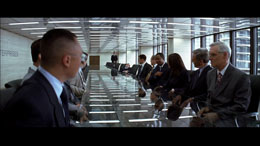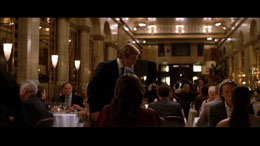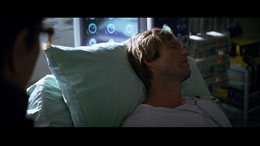|
A Zed and Two Noughts A Zed and Two Noughts, directed by Peter Greenaway in 1985 employs many uses of lighting; hard and soft light combinations as well as colour filters for lighting the scenes. In the first sequence, there is a 'zing' meaning a point source from the left that highlights the subject's hair, a fill light that illuminates the foreground and backlights that are slowly dimmed. The dramatic light from the background provides depth for the scene and may psychologically imply that the content of their conversation is of great significance. The second set of scenes are challenging to light, as one imagines the first scene, the backlight is reflected by exterior curtains while a large fill light and key light is focused on the subject on the bed. In the second scene, the camera crew is located where the bed is and at this low angle, the scene does not capture any of the shadows of the crew, but seamlessly incorporates the twin's shadows projected on the wall. Greenway adds even greater depth to the scene by including a hard lit window cucalorius – a cut-out pattern lights are placed behind – that increases the drama of the scene.
Equilibrium Equilibrium, a movie directed by Kurt Wimmer in 2002, has successfully captured the mood for two different worlds of a dystopia that suppresses human emotions by using drugs. The cinematography very subtly uses blue hard lighting for 'Libria,' the suppressing class while 'The Neathers,' possess a warm hue and a festive feeling by the soft reddish lighting. The screen captures describe firstly the transition into the Libria State, where the white vehicle is heading towards the hard blue light while leaving the reddish hues of the dilapidated Neathers. The second scene is of the items collected by the rebels from the Neathers and the misted scene evokes warmth in the red light while on the right hand side, the blue light suggests that the Libria state the room is hidden in. Thirdly, the questioning chamber in Libria state is of blue hues, with a hard light lit from the exit. These series of images show the distinction the cinematographer made in consideration of the worlds Wimmer has created.
Batman – The Dark Knight The Dark Knight, directed by Christopher Nolan in 2008 cleverly utilizes architecture as a disguise for its lighting techniques. This movie seamlessly incorporates the lighting into the story in its most natural setting, through the disguise of brightly lit spaces. Although the architecture of a set does help in creating softlights, keylights, fill light, back and set lights still apply. The first image is of the office where the many lights overhead conceals fill lights and key lights; but from the glow on the elder man's white hair on the right, there is the hint of a key light most likely pointed at the protagonist who is asleep at the middle of the table. The second image is of a dinning room where most likely there is a overhead keylight as well as eyelights for the close-up scenes to follow. Finally, the last image is of the subject discovering his deformity; the direct window pattern of light adds drama and helps to camouflage the computer graphics that will incorporate the deformed face upon the subject. Overall, Nolan's team has achieved a very naturally lit movie that accompanies the drama of the plot comprehensively.
*Images courtesy of Terri Meyer Boake
|
|||||
| INTRODUCTION | LIGHTING | EQUIPMENT | FILM REVIEWS | CONCLUSIONS | |
WORKS CITED
c. Elaine Lui










